
Brillat-Savarin is a soft-ripened triple cream cow's milk cheese with at least 72% fat in dry matter. It has a natural, bloomy rind. It was created c. 1890 as "Excelsior" or "Délice des gourmets" by the Dubuc family, near Forges-les-Eaux (Seine-Maritime). Cheese-maker Henri Androuët renamed it in the 1930s, as an homage to 18th-century French gourmet and political figure Jean Anthelme Brillat-Savarin.

Brie is a soft cow's-milk cheese named after Brie, the French region from which it originated. It is pale in color with a slight grayish tinge under a rind of white mould. The rind is typically eaten, with its flavor depending largely upon the ingredients used and its manufacturing environment. It is similar to Camembert, which is native to a different region of France. Brie typically contains between 60% and 75% butterfat, slightly higher than Camembert.

Camembert is a moist, soft, creamy, surface-ripened cow's milk cheese. It was first made in the late 18th century in Camembert, Normandy, in northwest France. It is sometimes compared in look and taste to brie cheese, albeit with a slightly lower butterfat content than brie's typical 60% and 75% by weight.
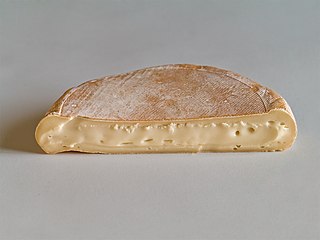
Reblochon is a soft washed-rind and smear-ripened French cheese made in the Alpine region of Haute-Savoie from raw cow's milk. It has its own AOC designation.

Cheesemaking is the craft of making cheese. The production of cheese, like many other food preservation processes, allows the nutritional and economic value of a food material, in this case milk, to be preserved in concentrated form. Cheesemaking allows the production of the cheese with diverse flavors and consistencies.

Blue cheese is any of a wide range of cheeses made with the addition of cultures of edible molds, which create blue-green spots or veins through the cheese. Blue cheeses vary in taste from very mild to strong, and from slightly sweet to salty or sharp; in colour from pale to dark; and in consistency from liquid or very soft to firm or hard. They may have a distinctive smell, either from the mold or from various specially cultivated bacteria such as Brevibacterium linens.
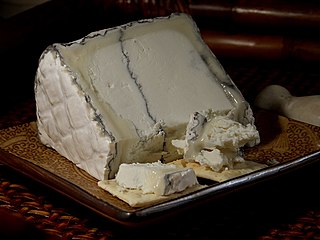
Humboldt Fog is a goat milk cheese made by Cypress Grove, of Arcata, California, in Humboldt County. It is named for the local ocean fog which rolls in from Humboldt Bay. It is an uncooked pressed cheese made from pasteurized goat's milk.

Neufchâtel is a soft, slightly crumbly, mold-ripened, bloomy-rind cheese made in the Neufchâtel-en-Bray region of Normandy. One of the oldest kinds of cheese in France, its production is believed to date back as far as the 6th century AD, in the Kingdom of the Franks. It looks similar to Camembert and Brie, with a dry, white, edible rind, but the taste is saltier and sharper. Unlike other soft-white-rinded cheeses, Neufchâtel has a grainy texture. It is usually sold in heart shapes but is also produced in other forms, such as logs and boxes. It is typically matured for 8–10 weeks and weighs around 100–600 g (3.5–21.2 oz).
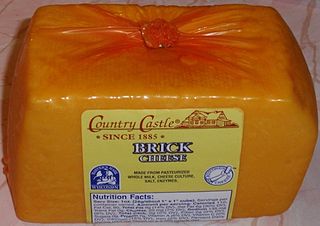
Brick cheese is a cheese from Wisconsin, U.S., made in brick-shaped form due to (originally) using actual bricks to form the shape. The color ranges from pale yellow to white with an orange rind. Unaged cheese has a sweet, mild flavor suitable for melting, while aged cheese has a stronger smell and a more nutty taste.

Stilbaai, also known as the Bay of Sleeping Beauty, is a town along the southern coast of South Africa about four hours by car from Cape Town. It is part of the Hessequa Local Municipality in the Western Cape province. Alternate spellings of the town's name include Still Bay.
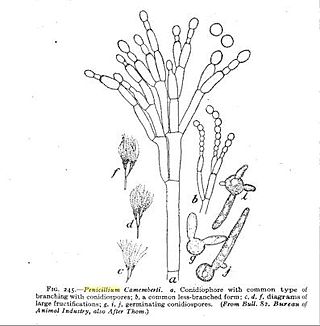
Penicillium camemberti is a species of fungus in the genus Penicillium. It is used in the production of Camembert, Brie, Langres, Coulommiers, and Cambozola cheeses, on which colonies of P. camemberti form a hard, white crust. It is responsible for giving these cheeses their distinctive flavors. An allergy to the antibiotic penicillin does not necessarily imply an allergy to cheeses made using P. camemberti.
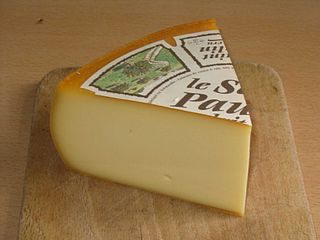
Saint Paulin is a creamy, mild, semi-soft French cheese made from pasteurized cow's milk, originally made by Trappist monks at Saint Paulin. It is a buttery cheese, but firm enough for slicing. Saint Paulin is similar to Havarti and Esrom, and is suited to serving as a table or dessert cheese; it is often served with fruit and light wine. Genuine Saint Paulin has an edible yellow-orange rind. It is ripened in a round loaf with slightly protruding sides, and matures in about four weeks.

There are many different types of cheese. Cheeses can be grouped or classified according to criteria such as length of fermentation, texture, methods of production, fat content, animal milk, and country or region of origin. The method most commonly and traditionally used is based on moisture content, which is then further narrowed down by fat content and curing or ripening methods. The criteria may either be used singly or in combination, with no single method being universally used.

Cheese ripening, alternatively cheese maturation or affinage, is a process in cheesemaking. It is responsible for the distinct flavour of cheese, and through the modification of "ripening agents", determines the features that define many different varieties of cheeses, such as taste, texture, and body. The process is "characterized by a series of complex physical, chemical and microbiological changes" that incorporates the agents of "bacteria and enzymes of the milk, lactic culture, rennet, lipases, added moulds or yeasts, and environmental contaminants". The majority of cheese is ripened, except for fresh cheese.
Washed-rind or smear-ripened cheeses are cheeses which are periodically treated with brine or mold-bearing agents. This encourages the growth of certain bacteria on their surface which give them distinctive flavors. There are hard and soft washed-rind cheeses. The softer ones are sometimes distinguished as "smear-ripened". Conversely, the term "washed rind" is sometimes reserved only for the hard ones.

Tulum cheese is a traditional Turkish goat's milk cheese ripened in a goatskin casing, called tulum in Turkish.

Kopanisti is a salty, spicy cheese, with protected designation of origin (PDO) produced in the Greek islands of the Cyclades in the Aegean Sea such as Mykonos, Tinos, Andros, Syros, Naxos etc.; it has been produced in Mykonos for more than 300 years. It owes its special peppery and spicy taste to rapid and extensive lipolysis and proteolysis caused by abundant microbial growth encouraged by repeated kneadings performed during the ripening process.
Golot or Kolot cheese, is one of the most important traditional cheeses produced in the region of East Black Sea, Turkey. The average composition of Golot cheese is 43.51% total solids, 5.31% fat, 33.64% protein, and 3.12% salt. The mixture of morning and night milk is heated to 37°C and separated from the fat. An appropriate amount of rennet and yogurt whey are added to the non-fat milk and then heated until the precipitation (65-70°C). The curd is then transferred into the cheesecloth for whey drainage about 15 hours. The cheeses are placed in a 50 kg (110 lb) polypropylene bags; granular cheeses are added between each Golot cheese and waited for one week. The Golot cheeses are pressed into wooden containers with cover and ripened between 6 months and 1 year based on the consumption period.

Limburger is a cheese that originated in the Herve area of the historical Duchy of Limburg, which had its capital in Limbourg-sur-Vesdre, now in the French-speaking Belgian province of Liège. The cheese is especially known for its strong smell caused by the bacterium Brevibacterium linens.
















